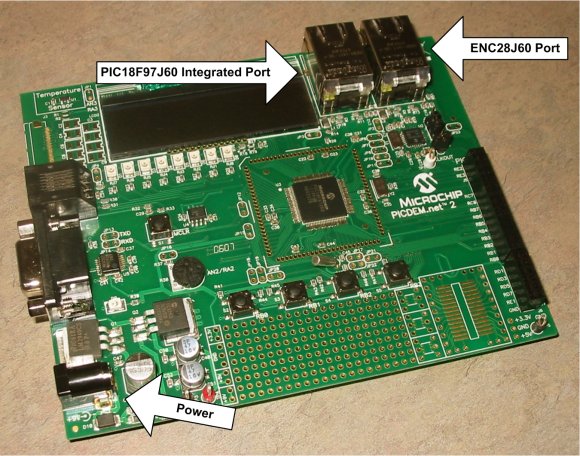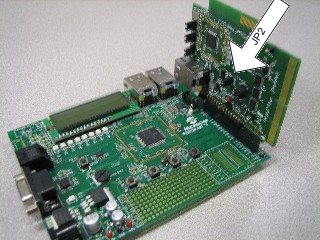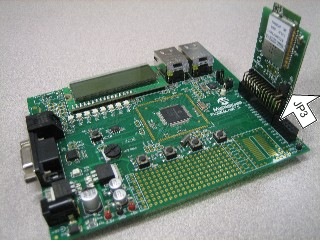Visit the Microchip web site to view the PICDEM.net 2  Product Page.
Product Page.
The PICDEM.net 2 development board comes populated with a PIC18F97J60 with an integrated Ethernet controller, as well as a standalone ENC28J60 Ethernet controller. The integrated controller is connected to the left Ethernet jack (closest to the LCD), and the standalone part is connected to the right one. By default the stack is configured to use the integrated controller, so the left port should be connected to the network cable. No other configuration of the board is necessary.
The User's Guide that shipped with this development board may refer to an older version of the TCP/IP Stack. This document updates much of that documentation for version 5.42.08.

Using the Fast Ethernet PICtail
By default, this board will use the ENC28J60 or the PIC18F97J60 for Ethernet communication. However, by connecting the Fast Ethernet PICtail to the PICtail connector on the board, you can use it to test the ENC624J600. To use the Fast Ethernet PICtail, insert it as shown in the picture, with header J4 on the PICtail inserted into connector J5 on the demo board.

The Fast Ethernet PICtail is designed to use the SPI communication bus when connected through a PICtail header, so the jumper settings are unused in this configuration, with one exception: the JP2 jumper on the PICtail, labeled ISENSE, should be shorted. The pre-compiled and pre-configured versions of the demo that correspond to this setup are already written to enable ENC624J600 functionality; for manual configuration information, see the ENCX24J600 configuration page.
Using the Microchip MRF24WB0MA / MRF24WG0MA 802.11b/g WiFi PICtail
The PICDEM.net 2 can be used to debug wireless functionality by connecting the PICtail as show in the picture, with header J1 on the PICtail inserted into connector J5 on the demo board.

Note if jumper JP3 exists, it must be shorted between pins 2 and 3 when used on this development platform.
Once your hardware is configured, you can program your board with your preferred demo project. The next few topics in the Getting Started section of this help file provide a tutorial for setting up the generic TCPIP demo application.